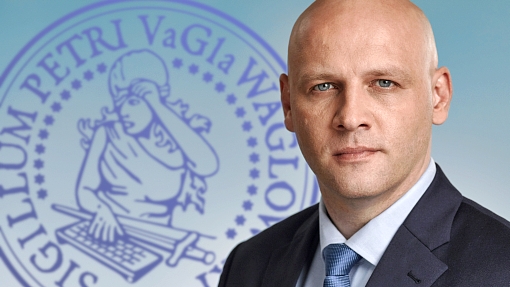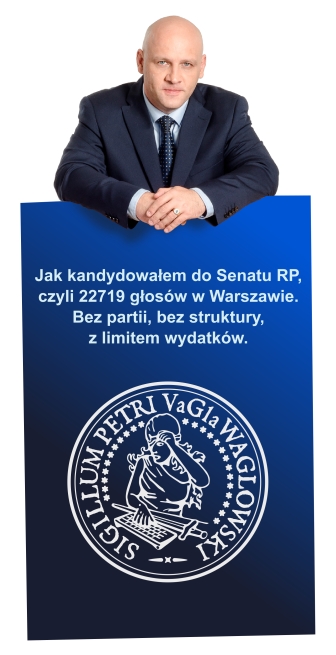Serwis zainspirował MI
 Inspiruję! W lutowym numerze Magazynu Internet Tomasz Kapelak opublikował obszerną recenzję serwisu prawo.vagla.pl. Dziękuje za werdykt, jednocześnie pragnę donieść, że na tak pozytywną recenzję nie zasłużyłbym, gdyby nie wykorzystany w serwisie "silnik" i wsparcie kolegów. Ja jedynie twórczo podszedłem do dostępnej w sieci (na licencji GPL) platformy do zarządzania treściami: drupal.org. No, ale css'y - i generalnie: layout - są moje! (OK. „Gmerałem” też trochę w silniku, ale tylko tyle, ile potrafi koder - hobbysta po Prawie) :) Uznałem, że warto powiedzieć kilka słów o tym Drupalu...
Inspiruję! W lutowym numerze Magazynu Internet Tomasz Kapelak opublikował obszerną recenzję serwisu prawo.vagla.pl. Dziękuje za werdykt, jednocześnie pragnę donieść, że na tak pozytywną recenzję nie zasłużyłbym, gdyby nie wykorzystany w serwisie "silnik" i wsparcie kolegów. Ja jedynie twórczo podszedłem do dostępnej w sieci (na licencji GPL) platformy do zarządzania treściami: drupal.org. No, ale css'y - i generalnie: layout - są moje! (OK. „Gmerałem” też trochę w silniku, ale tylko tyle, ile potrafi koder - hobbysta po Prawie) :) Uznałem, że warto powiedzieć kilka słów o tym Drupalu...
Już po przeczytaniu leadu artykułu zacząłem się obawiać. Autor pisze: "w dobie powszechnej komercjalizacji internetu serwisy oferujące wysokiej jakości, a przy tym darmowe informacje są bardzo cenne. Przykładem witryny tworzonej z pasją, o wysokim poziomie merytorycznym i wykonanej z zachowaniem obowiązujących standardów jest VaGla.pl Prawo i Internet". Zacząłem się obawiać - co się stanie, jak mi się noga powinie, albo - nie daj Boże - będę musiał się skomercjalizować... Wiadomo: pieluchy, małe buciki, większe buciki, jeszcze większe buciki; No ale nadal z uporem szukam żony, więc nie mam jeszcze tak wielkich wydatków ;) Ponoć jest taka metoda wywierania wpływu na ludzi - trzeba ich pochwalić na wyrost, żeby potem musieli (w sensie wewnętrznego imperatywu) sprostać roztoczonej przez chwalącego wizji. Magazyn Internet wysoko postawił poprzeczkę. Presja jest olbrzymia :)
Jeśli chodzi o Drupala - to fajne narzędzie. Moduły (wciąż rozwijane przez społeczność) pozwalają zbudować serwis niejako z klocków. Ta modułowość ma jednak swoją cenę - serwis oparty na Drupalu nie jest tak szybki i wydajny, jakby mógł być, gdyby przygotować go w sposób dedykowany dla konkretnej witryny. Jednak społeczność wciąż rozwija to narzędzie i powstają wciąż kolejne wersje (aktualnie "na tapecie" jest wersja 4.7.0 beta 4). Być może w kolejnych wersjach problemy te będą rozwiązane.
Z repozytorium modułów na pewno każdy wybierze coś dla siebie. Jeśli chodzi o moje życzenia - ktoś (ja nie umiem jeszcze) mógłby napisać moduł Biuletynu Informacji Publicznej. Co prawda zamknęłoby to "rynek" na tego typu rozwiązania oferowane obecnie, ale każdy rynek rządzi się wszak swoimi prawami. Po co kupować coś, co jest udostępniane przez społeczność nieodpłatnie? Po co wyważać „otwarte drzwi? (wiem co mówię – pracowałem w kilku zespołach nad dedykowanymi rozwiązaniami webowymi, ba! nawet kierowałem nimi). Natomiast warto zapłacić za dostosowanie takiego rozwiązania do własnych potrzeb i następnie jego konserwację (zatem byłaby jednak jakaś cena, ale nieporównywalnie niższa).
Serwis prawo.vagla.pl ma obecnie ponad 6 tys. artykułów. Przykładowo jedynie - Ministerstwo Spraw Wewnętrznych i Administracji ma ich 3768. Jeszcze nie oszalałem, by porównywać się z jakimkolwiek ministerstwem, ale jeśli ja (skromny prawnik bez wykształcenia informatycznego) mogę prowadzić serwis zyskujący pozytywne recenzje w branżowych miesięcznikach (i to w dziale poświęconym webmasteringowi), to myślę, że organizacja państwowa (mojego państwa) również jest w stanie sprostać wymogom rzetelnego informowania obywateli, wymogom dostępności, przejrzystości, generalnie – wymogom dobrej roboty webmasterskiej. To nie musi być sztuka i wodotryski. Wystarczy dobre rzemiosło. I właśnie dlatego warto pochwalić wspomniane wyżej MSWiA, które doprowadziło do tego, by w ramach serwisu tego ministerstwa znalazła się wydzielona część spełniająca wyśrubowane kryteria dostępności (potrójne A) a co w tej sytuacji oczywiste - także standardy semantycze wykorzystanego języka opisu dokumentu. Można też liczyć, że za przykładem tego ministerstwa (odpowiedzialnego wszak za informatyzację) pójdą też inne ministerstwa i agendy rządowe.
Wracając do Drupala: oczywiście są też niebezpieczeństwa. Niektórzy pamiętają zapewne, jak mi padła baza danych na początku migracji. Przydają się nabyte na studiach umiejętności szybkiego czytania podręczników (uważam, że na Prawie i Administracji też powinni uczyć zarządzania prawami i administracji systemami i bazami danych ;) Co do szybkiego czytania - MySQL Podstawy (280 stron) "łyknąłem" w 5 godzin. Co ważniejsze - udało mi się potem poprawić błąd. Przyznaję - słuchałem również rad życzliwych kolegów. Bez nich nie dałbym też rady postawić tego silnika wcześniej.
Tak więc, jeśli serwis zasłużył na pozytywny werdykt - sukces ten jest nie tylko moim udziałem. A jeśli ma wady - to jedynie przez moje lenistwo. Nie wszystko jeszcze ogarnąłem :)
Panie Tomku! Jest tak jak Pan napisał w artykule, a nawet jeszcze lepiej, bo od samego początku jestem w stanie każdemu użytkownikowi udostępnić inne „skórki” :) Zresztą Drupal ma taką opcję wbudowaną. Co więcej - wraz z dystrybucją można pobrać różne szablony i layouty i w panelu administracyjnym da się ustawić, by użytkownicy sami sobie wybierali sposób prezentacji treści! Ja jednak nie pozwoliłem im na to. Z jednej strony by nie rozmywać "wizerunku serwisu", z drugiej - by czerpać satysfakcję z katowania użytkowników moimi pomysłami na laytou :)
Kasat z eGospodarka.pl (pozdrawiam) powiedział ostatnio, że będę mógł w „za chwilę” żyć ze stawiania takich Drupali innym. Kto wie? Postawienie takiego serwisu to dwa dni pracy (wraz z instalacją wybranych wcześniej potrzebnych modułów). Jeden dodatkowy dzień na css'y i grafiki. (No dobrze - czasem to trwa znacznie dłużej). Reszta to - jak w przypadku tego serwisu - 9 lat gromadzenia treści...
- VaGla's blog
- Login to post comments
Piotr VaGla Waglowski

Piotr VaGla Waglowski - prawnik, publicysta i webmaster, autor serwisu VaGla.pl Prawo i Internet. Ukończył Aplikację Legislacyjną prowadzoną przez Rządowe Centrum Legislacji. Radca ministra w Departamencie Oceny Ryzyka Regulacyjnego a następnie w Departamencie Doskonalenia Regulacji Gospodarczych Ministerstwa Rozwoju. Felietonista miesięcznika "IT w Administracji" (wcześniej również felietonista miesięcznika "Gazeta Bankowa" i tygodnika "Wprost"). Uczestniczył w pracach Obywatelskiego Forum Legislacji, działającego przy Fundacji im. Stefana Batorego w ramach programu Odpowiedzialne Państwo. W 1995 założył pierwszą w internecie listę dyskusyjną na temat prawa w języku polskim, Członek Założyciel Internet Society Poland, pełnił funkcję Członka Zarządu ISOC Polska i Członka Rady Polskiej Izby Informatyki i Telekomunikacji. Był również członkiem Rady ds Cyfryzacji przy Ministrze Cyfryzacji i członkiem Rady Informatyzacji przy MSWiA, członkiem Zespołu ds. otwartych danych i zasobów przy Komitecie Rady Ministrów do spraw Cyfryzacji oraz Doradcą społecznym Prezesa Urzędu Komunikacji Elektronicznej ds. funkcjonowania rynku mediów w szczególności w zakresie neutralności sieci. W latach 2009-2014 Zastępca Przewodniczącego Rady Fundacji Nowoczesna Polska, w tym czasie był również Członkiem Rady Programowej Fundacji Panoptykon. Więcej >>








rozpowszechnianie wg GPL
Na 7thguard toczyła się ostatnio dyskusja na temat objęcia zakresem "copyleft" aplikacji webowych - w ten czy w inny sposób udostępnianych użytkownikom oprogramowania klienckiego na zdalnych serwerach.
Zacząłem się tam zastanawiać, czy przypadkiem już teraz prawo polskie w połączeniu z GPLv2 nie wymaga udostępniania takich aplikacji na warunkach tej licencji, o ile tylko ich oryginały też są na GPL. Kwestia ta nie jest jednak wyraźnie uregulowana nawet w projekcie GPLv3.
A jakie jest Twoje zdanie, VaGla? Czy czujesz się zobowiązany do udostępnienia swoich zmian w Drupalu na warunkach GPL? (Zastrzegam, że nie wiem, czy licencja tego projektu nie wprowadza jakichś zmian do GPL. Rozumiem też, że Drupal to nie to samo co aplikacja webowa.)
To znacznie bardziej skomplikowane ze względu na modułowość
O ile sam silnik jest na licencji GPL, to już niektóre moduły są (mogą być) na innych licencjach. Sama zaś licencja stwierdza (za jednym z nieoficjalnych polskich tłumaczeń): "samo tylko połączenie z Programem (lub z pracą opartą na Programie) innej pracy - nie opartej na Programie, w ramach wolumenu nośnika przechowywania lub dystrybucji, nie powoduje objęcia takiej pracy zakresem niniejszej Licencji"
Sam Drupal: "Drupal is open source software licensed under the GPL, and is maintained and developed by a community of thousands of users and developers. Drupal is free to download and use. If you like what Drupal can do for you, please work with us to expand and refine Drupal to suit your needs". Treść "podręczników": "The Drupal handbook pages are © copyright 2000-2005 by the individual contributors and can be used in accordance with the Creative Commons License, Attribution-ShareAlike 2.0". Moduły pisane przez społeczność mogą być na jeszcze innych licencjach (w tym na licencjach "własnościowych"). Co do zasady - licencja GPL wykorzystywana w wielu modułach Drupala to licencja GPL 2.0.
To trudne by ustalić gdzie jest granica "outputu". Generalnie założenie modułowości tego rozwiązania powoduje, że każdy dodatek do skryptów (np. w postaci nowych modułów) jest "uprawniony". Ten system działa w ten sposób, że można napisać moduł w PHP, który "wpływa" na działanie każdego innego elementu silnika (jednak nie modyfikuje tamtego kodu). Na podstawie zaś licencji: "The act of running the Program is not restricted, and the output from the Program is covered only if its contents constitute a work based on the Program (independent of having been made by running the Program)". Aplikacje webowe mają taką właściwość (to wynika ogólnie z koncepcji W3C) by oddzielić silnik, od treści, oraz to wszystko od tego co widać w przeglądarce (czyli outputu). A i tak to uproszczone jest jeszcze, bo tych niezależnych "warstw" działania aplikacji webowych jest więcej (np. ten sajt prezentowany jest dzięki napisanemu od początku szkieletowi .xtmpl (nie chciałem oryginalnego outputu w tabelkach i postawiłem na div'y), który jednak "koresponduje" z xtemplate.engine, który nota bene też jest inny niż oryginalny - a to wszystko niezależne od siebie, chciaż korespondujące właśnie ze sobą "warstwy" aplikacji).
Ja swoje css'y (pliki zupełnie niezależne od silnika Drupala - wszak da się uruchomić serwis bez css'ów) napisałem od początku :) Zresztą! Wystarczy sprawdzić źródła strony, zobaczyć gdzie jest link zaszyty do pliku css - i jeśli ktoś ma ochotę - może ten plik w każdej chwili pobrać i wykorzystać (co więcej - robi to za każdym razem, gdy wchodzi na stronę, a przeglądarka działa z opcją wykorzystania css'ów). Czy miałbym coś przeciwko temu, żeby ktoś postawi sajt z wykorzystaniem napisanych przeze mnie css'ów? Pewnie miałbym, ale z innego powodu, a to ze względu na to, by mój sajt odróżniał się jakoś wizualnie od innych (co to by było za życie, gdyby dokładnie te same parametry stylów były wszędzie w sieci?). Css'y są jeszcze czymś innym niż grafiki wykorzystane w serwisie (do konstrukcji layout'u, albo np. takie logo). Jak widać z tego - zależności jest wiele. Są też opisane w licencji pewne warunki (pkt 2), w których nie jest konieczne spełnienie warunków licencji, w tym "ujawniania" źródeł. Ale generalnie problem w tym co oznacza "dystrybucja" (rozpowszechnianie lub publikowanie - jak chce jedna z nieoficjalnych polskich wersji licencji) w rozumieniu GPL v. 2.0
Ze względu na modułowość Drupala ważne jest np. postanowienie licencji (za polskim tłumaczeniem podlinkowanym powyżej): "Niniejsze wymogi odnoszą się do zmodyfikowanej pracy jako całości. Jeśli dające się ustalić sekcje danej pracy nie pochodzą od Programu i mogą być racjonalnie uważane za samodzielne i odrębne same w sobie, to niniejsza Licencja i jej warunki nie mają zastosowania do takich sekcji przy rozprowadzaniu ich przez ciebie jako odrębne prace". Wystarczy "wykasować" moje niezależne dodatki, pliki z hakami i "inne wynalazki" - i masz Drupala jakbyś go właśnie pobrał ze strony tego projektu. Modułowość nie oznacza ingerencji w kod innego twórcy :)
Pytasz Krzysztofie do czego się czuje zobowiązany. Czułem się zobowiązany do tego, by w momencie, gdy chwalą serwis na łamach MI - poinformować publiczność, że sajt jest oparty na takim a nie innym silniku (na marginesie dodam, że informacja o wykorzystaniu w tym serwisie Drupala oraz link do sajtu tego projektu znajduje się w jego stopce). Poza wszystkim - nie dystrybuuje aplikacji, a uruchamiam ją. To też ma wpływ na ocenę zastosowania warunków licencji.
Aby było wiadomo czego dotyczy ta dyskusja - poniżej przedstawiam oryginalną licencję, o której mowa (a która załączona jest do silnika i do niektórych modułów):
--
[VaGla] Vigilant Android Generated for Logical Assassination
rozpowszechnianie
Rzuciłem szybko okiem na dyskusję na 7thG i niestety się przeraziłem - straszne pomieszanie pojęć tam panuje.
Myli się rozpowszechnianie programu jako takiego z udostępnianiem skutków jego działania, nie odróżnia się udostępnienia aplikacji innym od umożliwienia samodzielnego urchomienia oddzielnej instancji programu komputerowego.
Nie jestem pewien czy z faktu, że 7thG powstał na GPLowych narzędziach wynika fakt, że autor 7thG ma obowiązek udostępnić mi kod pozwalający na uruchomienie funkcjonalnie równoważnego serwisu.
Być może (w GPLv4?) będzie trzeba w przyszłości udostępniać
zawartość baz danych treści, komentarzy gdyż "zostały stworzone przez wolne oprogramowanie" i "informacja chce być wolna"?
Tak sobie trolluję :)
--
[S.A.P.E.R.] Synthetic Android Programmed for Exploration and Repair
cztery wolności użytkowników
Istotny element odpowiedzi na pytanie, czy dany program jest objęty klauzulą "copyleft" uzyskamy wykazując, czy jest on opracowaniem (utworem zależnym) programu na licencji GPL.
Ale nie o tym chciałem dyskutować. Pytając do czego czujesz się zobowiązany chodziło mi o to, czy jeżeli uznamy zasadność istnienia następujących wolności użytkownika:
to, czy takie wolności powinny przysługiwać nie tylko użytkownikowi, który korzysta z programu zainstalowanego na jego komputerze, ale także takiemu, który korzysta z programu udostępnionego mu zdalnie?
Sytuacja z serwisem zbudowanym na modyfikacji Drupala to chyba krok dalej - internauta korzysta w zasadzie tylko i wyłącznie z wyniku działania takiego programu.
Piszę szybko, ale mam nadzieję, że zrozumiale.